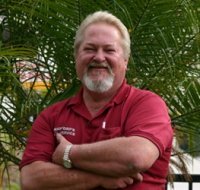You Can Repair Your RV's Fiberglass Roof!
Fiberglass roofs are much less common than rubber roofs, and for this reason it can often be pretty darn difficult to find good repair information for them. But that's why we've written this page for you. So look no further!
Save Money, Do It Yourself!
There is no reason you cannot seal your own roof! It just takes the proper knowledge and a little bit of effort.
Knowledge, you'll find on this page; effort, well that's up to you my friend!
The proper steps in repairing a fiberglass roof are similar to repairing a metal roof or a rubber roof. However, in this case there are two different options in terms of the sealant, and you will want to use the type of sealant that is best for your specific fiberglass roof.
Again, Please Note: There are different types of fiberglass roofs; you'll need to talk your local RV parts supplier or RV service professional for what process and materials to use for your specific roof. I will explain both options here, but I don't recommend you try one or the other without consulting a professional first as to which will be a better fit for you.
The correct process for repairing your RVs roof is not difficult, but doing it correctly is very important to preventing a leak. So where do you start?
Getting Started - Removing Old Seal and Cleaning
Unlike a rubber roof, you can remove the old sealer on a fiberglass roof without causing any damage, and in fact, it is important that you do so in the areas that look questionable.
The hand scraper is a common tool that you can buy at your local hardware store.
Remove any loose, curled, or flakey bits you find in your old seal. You can do this easily by purchasing a hand scraper to cleanly remove all old sealer that looks damaged. There's no need to remove the seal where it is still intact and looking good; you'll just apply the new sealer over these good areas. But you do need to take care to remove all the bad spots on the old seal to ensure that the new roof sealer can do its job.
Then, before you start opening up any sealer, you will need to thoroughly clean all areas you intend to apply the sealer to in order to ensure the best possible bond. You can do this simply with a household broom. (If you use the second option below you'll also want to add some mild detergent, but I'll explain that down there).
Once this is done, you are now ready to start resealing your roof.
Option 1 - Self-leveling Sealer
The first option when repairing your fiberglass roof is with a self-leveling sealer. You will need to purchase a tube of self-leveling sealer along with a calking gun used to apply it. These can be found at an RV parts store and are very affordable. I recommend you purchase at least one pair of rubber gloves because you will most likely get some of the sealer on your hands. It is recommended that you talk to your RV service center for the proper specific materials to purchase.
Using A Paint Roller?
Note: Completely sealing a fiberglass roof using a paint roller is a bad idea and could create more problems than it solves. So make sure to seal only the seams.
To apply the sealer, squeeze it out of the tube using the caulking gun and completely cover the area that is to be sealed. It might be helpful to use a two inch brush to make sure the sealer is covering the entire area. It might also be easier and more precise to use your finger, especially when you are repairing a larger area. (This is where the rubber gloves will come in handy.)
You should put down a strip of sealer a half inch to an inch wide in normal areas of your seal. When you encounter areas with screws, you should pay close attention and increase the width of your application because these are the areas that are most likely to cause leaks, even after your rubber roof repair is done if not done properly.
Continue this process over all areas that are questionably bad and you should have a sturdy, leak-protecting seal. The sealer will dry completely in a day or so and provide a strong seal that will probably last 5-10 years. There is no guarantee that it will last a full 5 years or more, but from my experience 5-10 years is the norm.
Option 2 - Regular Seal
For the second option you will again need to thoroughly clean all areas you intend to apply the sealer to ensure the best possible bond. You can start to do this by sweeping the seams down with a household broom, but before you seal anything you will need to further clean the seal using a rag with a mild detergent and water.
You will also need to purchase a can of roof sealer that comes in quart or gallon sized cans, along with a two inch paint brush to apply it with. These cans can be found at an RV parts store and are very affordable.
To apply the sealer dip the brush in the can and brush it onto the damaged area. You need to make sure that the sealer covers the entire area or you will be wasting your time. To do this, you should put down a strip of sealer a half inch to an inch wide.
Have Enough Sealer?
If you have any doubt whether or not you have put enough sealer on your roof it doesn't hurt to put a little extra.
Better safe than sorry here because if you don't put enough on there is a good chance it will leak sooner than you expect it to.
As mentioned with the self-leveling sealer above, You should make your application wider and pay more attention to areas that have screws because these are the areas most likely to cause leaks.
Continue this process over all areas that are questionably bad and you should have yourself a sturdy, leak-preventing seal, if it wasn't already too late for the leaks. The sealer will dry completely in a day or so and provide a strong seal that will most likely last 5-10 years. There is no guarantee that it will last a full 5 years or more, but from my experience 5-10 years is normal.
Again, please consult with a professional before trying either of these methods. Remember to continue to maintenance your fiberglass roof by continuously checking for cracks in the seal. It is also necessary to reseal the entire roof every 5-10 years to prevent yourself from missing a small crack that could lead to a large leak after one hard rain.
Congratulations! Your RV fiberglass roof repair is finished, and you didn't even have to spend much to do it!
Enjoy this page? Please help us pay it forward to others who would find it valuable by Liking, Sharing, Tweeting, Stumbling, and/or Voting below.
Have a question about this topic?
Have a question about your RV? Chat with an expert one-on-one now.*
*Chat provided by JustAnswer.com, a third party not affiliated with MSRVR
 Fiberglass roof repair? No problem! We've got the info you need.
Fiberglass roof repair? No problem! We've got the info you need.
or
Kind Words From Our Visitors

Hi, I'm Robbie. Welcome to Money-Saving-RV-Repair.com!
Like the name implies, this site is all about helping you save money while keeping your RV in tip-top shape--and that is all about you having the knowledge to do so.
I've been a technician in the RV industry for 30 years, operating out of San Diego, California. And let me tell you, I love my job.
But I also love empowering RVers with the knowledge they need to make the right decision on repairs, or to make the fix themselves--and that, my friend, is the reason for this website. I hope you enjoy.
Or, learn more about me, my RV service practice, & this website here.


